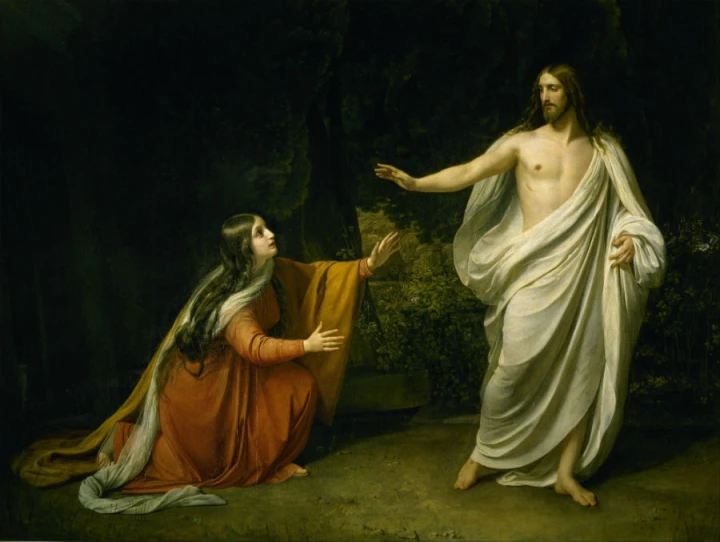Yet in our everyday and in contemplating our faith, we tend to focus more strongly on the sadness and pain of the Crucifixion than on the triumph of the Resurrection. Christ died on the cross for the forgiveness of sin and as proof of his love for us. However, as Christians we know that his death would be meaningless without the Resurrection. Blessed John Duns Scotus explained the Incarnation as the culmination of creation and as intended from the beginning of time. Accordingly, it had been God’s original idea to ultimately unite with himself the whole of creation, “in the Person and Flesh of the Son” whose saving Passion is the expression of God’s loving will. (Pope Benedict XVI, Holy Men and Women of the Middle Ages, pp. 88f.) The great triumph of Christ’s Resurrection is thus what God had in mind for us from the start and it marks the beginning of the glorious love affair that calls us to eternal closeness with the Father.
The Resurrection is the great turning point for humanity. It is also the most difficult to grasp of all gospel events as, indeed, the promise of the Resurrection was initially unintelligible even to the disciples. Jesus had “entered upon a different life, a new life.” It was a resurrection into “definitive otherness” – a oneness with God. Because Christ and God are now one, he is with us always. The Resurrection must thus be understood as a “universal event, as the opening up of a new dimension of human existence.” (Pope Benedict XVI, Jesus of Nazareth: Holy Week, p. 244)
Yet, to make the Easter experience part of our everyday remains a challenge for many – we are still focused on the cross. When his followers encounter Jesus at Emmaus and the Lake of Gennesaret and when he appears to Mary Magdalene, none of them recognize him at firs. “Just as day was breaking, Jesus stood on the beach; yet the disciples did not know that it was Jesus.” (John 21:4) It is only through an internal recognition, as sense of his presence, rather than physical recognition, that they see him: “None of the disciples dared ask him, ‘Who are you?’ They knew it was the Lord.” (John 21:12) At Emmaus, he is only recognized as he breaks the bread and vanishes before the disciples’ eyes: “And they recognized him; and he vanished out of their sight.” (Lk 24:31) The risen Lord’s new existence, still embodied, is of a mysterious nature, no longer bound by space and time or physical laws. Similarly, St. Paul encounters the risen Christ as a light that shone “brighter than the sun.” (Acts 26:13) How about our own encounter with the Risen One? Do we recognize Him by our side? Are we aware of Him? Are we willing to see Him? To follow Him? This is our Easter challenge – our daily challenge.
Christ now lives in fellowship with God. He and God are one. And this is the beginning or our own story as Christians. The gospels describe concrete encounters between the risen Lord and his immediate followers and thus present a mirror of our own personal experiences with Christ. The Resurrection opened up within God a space for humanity. It comprises both our own hope of resurrection and signifies our daily possibility of closeness with God through our relationship with Christ.
Christ’s final Ascension into heaven contains the promise that his presence is truly universal. Only by departing from his disciples could he return to all of us in a new form of closeness. Only that can explain the disciples’ joy after Christ leaves them: “Then he led them out as far as Bethany, and lifting up his hands he blessed them. While he blessed them, he parted from them, and was carried up into heaven. And they worshiped him, and returned to Jerusalem with great joy, and were continually in the temple blessing God.” (Luke 24:50-53) Pope Benedict XVI emphasizes the universal meaning of the Resurrection: “Through his power over space, he is present and accessible to all – throughout history and in every place.” (Holy Week, p. 284) Christ promised his disciples on Ascension “I will go away and I will come to you.” (John 14:28) That, according to Pope Benedict, is “the essence of Christian trust, the reason for our joy.” (Holy Week, p. 285)
But even when we claim to recognize the event of the Resurrection, do we sincerely rejoice? Or do we give in to “trembling and astonishment” as the women by the empty tomb? Do we fear to ponder its personal meaning to us as a life-changing event? Do we turn away from the “blinding light” in fear of the challenges it might bring to our lives? Or do we live as true Christians with the joy of the Resurrection and an openness to what it pertains? The empty tomb, once discovered, should change our personal fate forever. In addition, knowledge of the Resurrection is clearly not a private matter. We are called to be witnesses and live the truth, to live its joy.


